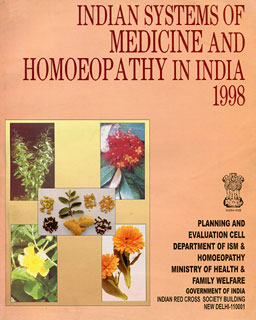Preface:
Considerabie interest has been generated of late in the infrastructure available under the Indian Systems of Medicine and Homoeopathy Sector. The foundation of these systems rests to a large extent on the strength and diversity of the institutions, hospitals and practitioners involved in teaching, research and clinical care. The Department of Indian Systems of Medicine & Homoeopathy , which came into being in 1995, has initiated a number of measures to enable each system of Indian Medicine viz. Ayurveda, Siddha, Unani and also Homoeopathy to develop according to its own concepts and philosophy. Institutions imparting training in Yoga and Naturopathy have also received impetus. The objective of all these efforts has been to render simple, efficacious remedies to people, particularly in the area of preventive health, maintaining healthy life styles, alleviating discomfort caused by specific illnesses and treating chronic disorders. Naturally, there is a great interest in the institutions and health manpower through which such medical and health care services are extended.
For the purpose of successful regulation and development of the different systems for policy planning and for determining strategies which are relevant to the needs of the people, it is necessary to have accurate statistical 'Information on the availability of medical facilities, medical man power, medical education, colleges (under graduate and post graduate), licensed pharmacies and institutions in receipt of Government grants. This XVI issue of the present publication includes detailed information on all these aspects. l hope this publication will be found useful by all those who are engaged in the development of these systems in India and abroad whether prompted by an interest in policy planning, research, provision of medical services or development of trade and commerce in medicinal products based on the indigenous systems.
The present compilation includes information available as on 31.3.1998. Wherever available information up to 1.4.99 has been incorporated. This publication would not have been possible without the co-operation of the Directorates of Indian Systems of Medicine and Homoeopathy, Boards of ISM&H in the States/UTs, Principals of medical Colleges and heads of several other institutions. l thank them all for their co-operation.
l would also like to place on record my deep appreciation for the efforts made by the officers and staff of the Planning and Evaluation Cell of the Department who worked under the overall guidance of Sh. O.S. Veerwal, Director (ISM) in bringing out this publication.
Suggestions for improvement are welcome. Errors and omissions, if any, may kindly be brought to the notice of Director/Deputy Director (Planning and Evaluation), Department of ISM&H, Ministry of Health and Family Weifare, IRCS Annexe Building, Red Cross Road, New Delhi-110001.
New Delhi:
(SMT. SHAILJJA CHANDRA)
SECRETARY (ISM&H)
 Wishlist
Wishlist






